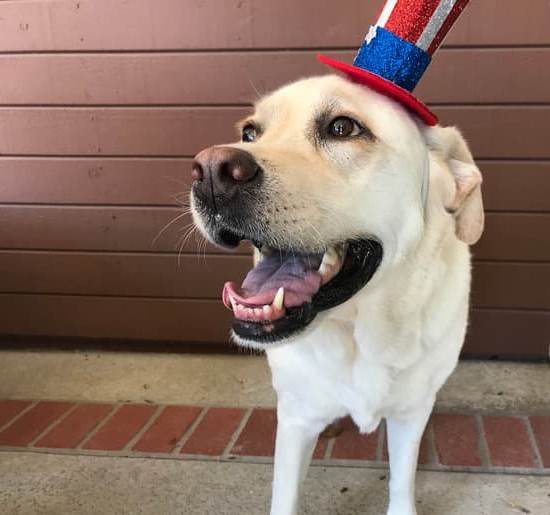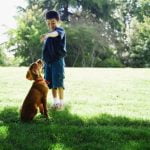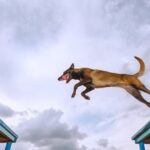It’s a common sight for dog owners: their furry companions taking off in hot pursuit of rabbits. Many wonder, “Can you train a dog not to run after rabbits?” Understanding the instincts of a dog is key to addressing this behavior. Dogs have a natural instinct for chasing prey, and rabbits trigger this instinct.
The urge to chase after rabbits can be dangerous for both dogs and the rabbits themselves. Allowing your dog to run after rabbits can lead to potential injuries from rabbit bites, fights with other animals, or getting lost in unfamiliar areas. It’s essential for pet owners to address this behavior for the safety of their dogs and local wildlife.
So, can you train a dog not to run after rabbits? This article will explore various training techniques, such as positive reinforcement training using treats and rewards, establishing and maintaining boundaries through consistency, managing the environment to minimize rabbit encounters, seeking professional help when DIY training isn’t enough, and the role of exercise and mental stimulation in preventing rabbit-chasing behaviors.
With the right approach and understanding of your dog’s instincts, it is possible to train them not to chase after rabbits.
The Dangers of Allowing Your Dog to Run After Rabbits
Allowing your dog to run after rabbits can pose several dangers, not only to the rabbits themselves but also to your dog and potentially to other animals. When a dog chases a rabbit, it’s important to understand that this behavior is driven by their natural instincts as hunters. The sight of a rabbit triggers their prey drive, causing them to exhibit behaviors such as barking, lunging, and giving chase.
One of the dangers of allowing your dog to run after rabbits is the risk of injury. Dogs that are not properly trained to restrain themselves from chasing rabbits can easily get injured while in pursuit. They might stumble into hazardous terrain, become entangled in underbrush, or even be involved in altercations with wild animals who defend themselves against the chase.
Another concern is the impact on wildlife populations. If your dog is allowed to freely chase rabbits in natural areas, there may be negative consequences for local ecosystems. This activity can disrupt habitats and lead to a decline in prey species populations.
In order to address these dangers and prevent potential harm caused by allowing your dog to run after rabbits, it’s essential for dog owners to take responsibility and implement proper training and management techniques. These will ensure the safety of both their dogs and local wildlife populations.
| Danger | Impact |
|---|---|
| Risk of Injury | Potential harm or danger for dogs while chasing rabbits |
| Wildlife Impact | Possible disruption in local ecosystems due to uncontrolled rabbit chasing by dogs |
Can You Train a Dog Not to Run After Rabbits
Dogs have a strong natural instinct to chase small animals, including rabbits. This behavior is rooted in their ancestry as hunters and scavengers. The movement of a rabbit triggers a dog’s prey drive, prompting them to give chase. This instinct is deeply ingrained in their nature, and it can be challenging to completely eliminate.
The Dangers of Allowing Your Dog to Run After Rabbits
Allowing your dog to engage in rabbit chasing can pose serious risks for both your pet and the rabbits themselves. When dogs run after rabbits, they are at risk of getting lost, injured, or even killed, especially if they venture into unfamiliar territory or onto roadways. Additionally, the stress and fear induced by being chased can have harmful effects on rabbits, potentially leading to injury or death.
Positive Reinforcement Training: Using Treats and Rewards to Deter Rabbit Chasing
One effective way to train a dog not to run after rabbits is through positive reinforcement training. By using treats and rewards, you can teach your dog that ignoring rabbits and following your commands results in positive outcomes. When your dog successfully resists the urge to chase a rabbit or responds to your command to stop, providing treats and praise reinforces this desired behavior. Here are some specific techniques you can use:
- Practice “leave it” exercises with your dog using toys or treats
- Use a long leash when walking your dog in areas with rabbit populations
- Reward your dog for paying attention to you when encountering rabbits
By consistently rewarding alternative behaviors and maintaining patience, you can help redirect your dog’s instincts and minimize their desire to chase rabbits.
Consistency Is Key: How to Establish and Maintain Boundaries
In addition to positive reinforcement training, it is crucial to establish clear boundaries for your dog when it comes to chasing rabbits. Consistency is key in reinforcing these boundaries. It’s important for all members of the household – as well as any visitors – to adhere to the same rules regarding rabbit chasing. Maintaining consistent expectations will help reinforce the training and prevent any confusion for your pet.
Positive Reinforcement Training
Training a dog not to run after rabbits can be a challenging but achievable task, especially with the use of positive reinforcement techniques. Positive reinforcement training involves rewarding your dog for good behavior rather than punishing them for unwanted behavior. When it comes to deterring rabbit chasing, this approach can be highly effective in redirecting your dog’s focus and teaching them to resist their natural instincts.
One of the most common methods of positive reinforcement training is using treats and rewards to encourage desired behaviors. When your dog chooses not to chase after a rabbit, immediately praise them and offer a high-value treat as a reward. Over time, they will learn to associate not chasing rabbits with receiving something they love, making it more likely that they will repeat this behavior in the future.
To effectively implement this training technique, it is important to have a consistent approach. This means that every time your dog refrains from chasing a rabbit, they should receive positive reinforcement in the form of treats and praise. Additionally, it is crucial to ensure that all family members and anyone else interacting with your dog are on the same page and provide consistent rewards for appropriate behavior.
In addition to using treats and rewards, you can also incorporate other forms of positive reinforcement such as verbal praise, toys, or access to favorite activities as a way of incentivizing your dog to resist the urge to chase rabbits. By consistently rewarding desirable behavior and creating a positive association with not chasing rabbits, you can effectively train your dog to refrain from engaging in this instinctual behavior.
Consistency Is Key
Establishing and maintaining boundaries for your dog is crucial when training them not to run after rabbits. Consistency is the key to helping your dog understand what behavior is acceptable and what is not. By being consistent in your training approach, you can effectively communicate to your dog that chasing rabbits is not allowed.
Setting Clear Rules and Boundaries
When training your dog not to run after rabbits, it’s important to set clear rules and boundaries. Establishing these guidelines will help your dog understand what is expected of them. This can include teaching them commands such as “leave it” when they show interest in chasing a rabbit, as well as providing positive reinforcement when they obey.
Training Techniques That Reinforce Boundaries
Using positive reinforcement techniques can be effective in reinforcing boundaries and discouraging rabbit chasing behavior. Rewarding your dog with treats or praise when they exhibit the desired behavior of not chasing rabbits can help solidify the boundaries you have set. Consistently rewarding good behavior will reinforce the idea that refraining from chasing rabbits leads to positive outcomes.
Maintaining Consistency in Training
Consistency is crucial when establishing and maintaining boundaries for your dog. This means that all members of the household should be on the same page when it comes to enforcing rules about rabbit chasing. Additionally, consistency also entails practicing the same training techniques regularly until the desired behavior becomes a habit for your dog. By maintaining this consistency, you can effectively train your dog not to run after rabbits.
Managing Your Dog’s Environment to Minimize Rabbit Encounters
When it comes to training your dog not to run after rabbits, managing their environment plays a crucial role in preventing encounters with these tempting creatures. By creating a controlled environment, you can minimize the chances of your dog being able to chase rabbits, ultimately making the training process much easier.
Secure Fencing and Leashes
One of the most effective ways to manage your dog’s environment and minimize rabbit encounters is by ensuring that your property has secure fencing. This will prevent your dog from having access to areas where rabbits may be present. Additionally, using a leash when walking your dog in areas where rabbits are commonly seen can also help control their movements and prevent them from running off after rabbits.
Supervised Outdoor Time
Another strategy for managing your dog’s environment is to supervise their outdoor time. By keeping an eye on them while they are outside, you can quickly intervene if they show any signs of wanting to chase a rabbit. This hands-on approach allows you to redirect their attention and reinforce positive behaviors when it comes to resisting the urge to chase animals.
Creating Safe Indoor Spaces
Lastly, creating safe indoor spaces for your dog can also contribute to managing their environment. Ensuring that they have plenty of mental and physical stimulation indoors through toys, interactive games, and regular playtime
By managing your dog’s environment effectively, you can take proactive steps towards minimizing rabbit encounters and setting the stage for successful training efforts focused on preventing rabbit chasing behaviors.
Seeking Professional Help
Some dogs can be particularly difficult to train not to run after rabbits, especially if they have a strong prey drive. If you’ve tried various training techniques and your dog still can’t seem to resist chasing rabbits, it may be time to seek professional help. A professional dog trainer or behaviorist has the expertise and experience to address this challenging behavior and provide personalized training strategies.
Professional help is especially beneficial if your dog’s rabbit chasing behavior poses a danger to themselves, other animals, or people. A qualified trainer or behaviorist can assess the underlying reasons for your dog’s behavior and develop a tailored training plan that considers your dog’s specific needs, temperament, and triggers.
Additionally, seeking professional help can also provide you with valuable guidance on identifying early signs of rabbit chasing tendencies in young puppies or newly adopted dogs. Early intervention from an experienced trainer can prevent the development of ingrained habits, making it easier to modify your dog’s behavior before it becomes a persistent issue.
| Professional Help Benefits | Factors to Consider |
|---|---|
| Expertise in addressing challenging behaviors | Assessment of underlying reasons for rabbit chasing |
| Personalized training strategies | Early intervention for young puppies or newly adopted dogs |
| Safety considerations for dogs, other animals, and people | Tailored training plans based on individual dog’s needs and triggers |
The Role of Exercise and Mental Stimulation in Preventing Rabbit Chasing Behaviors
In conclusion, the instinct of a dog to chase rabbits is deeply ingrained and often difficult to completely eradicate. However, with the right training techniques and consistent effort, it is possible to significantly reduce this behavior in your dog. Positive reinforcement training can be effective in teaching your dog that chasing rabbits is not acceptable, rewarding them for desirable behaviors and ignoring or redirecting undesirable ones.
Consistency is key when it comes to establishing and maintaining boundaries for your dog. This means enforcing rules at all times and not making exceptions, as mixed signals can confuse your pet. It is essential to manage your dog’s environment in order to minimize their opportunities for encountering rabbits. Keeping them on a leash or using a secure containment system can prevent them from indulging their natural instincts.
While many pet owners are able to successfully train their dogs not to run after rabbits on their own, there are instances where seeking professional help may be necessary. A certified dog trainer or behaviorist can provide expert guidance and support tailored to your specific situation, especially if your dog’s rabbit-chasing behavior poses a danger to themselves or others.
In addition, ensuring that your dog receives regular exercise and mental stimulation through walks, playtime, and interactive toys can also help deter rabbit-chasing behaviors by keeping them engaged and fulfilled. So yes, you can train a dog not to run after rabbits by using these techniques and methods consistently over time.
Frequently Asked Questions
How Do I Train My Dog Not to Run After Animals?
Training your dog not to run after animals requires consistent and patient effort. Start by teaching basic commands like “sit” and “stay”, then practice with a leash in a controlled environment. Gradually increase distractions and reinforce positive behavior.
How Do I Get My Dog to Stop Eating Rabbits?
To stop your dog from eating rabbits, first make sure they are getting enough exercise and mental stimulation. Then, work on training them to leave rabbits alone using positive reinforcement techniques such as treats and praise.
Why Does My Dog Go After Rabbits?
Dogs go after rabbits due to their natural instincts as predators. The sight, sound, and smell of a rabbit can trigger a dog’s hunting behavior, especially if they have not been properly socialized or trained to control these instincts. Regular training and supervision can help address this behavior.

Welcome to the blog! I am a professional dog trainer and have been working with dogs for many years. In this blog, I will be discussing various topics related to dog training, including tips, tricks, and advice. I hope you find this information helpful and informative. Thanks for reading!





